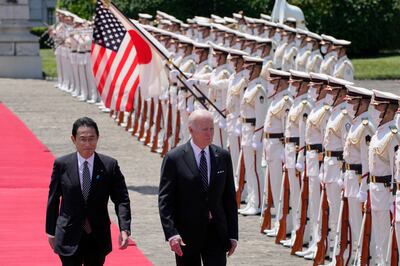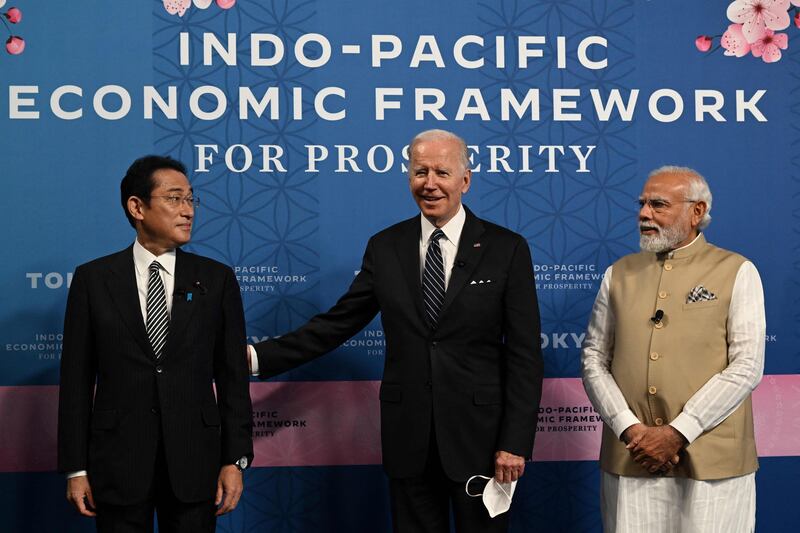President Joe Biden's administration announced that a dozen Indo-Pacific countries will join the US in a sweeping economic alliance designed to counter China’s influence in the region, even as questions remain about its effectiveness.
The nations involved in the Indo-Pacific Economic Framework (IPEF) constitute about 40 per cent of global gross domestic product, says the White House, which has touted its launch as a marquee accomplishment of Mr Biden’s first trip to Asia. Australia, India, Japan, South Korea and New Zealand were included, along with seven South-east Asian countries.
“The United States is deeply invested in the Indo-Pacific,” Mr Biden said on Monday at an event in Tokyo launching the partnership. “We’re committed for the long haul.”
Democrats and Republicans in Congress have questioned the move because it doesn’t include a goal of negotiating mutual tariff reductions to make US exports cheaper for consumers in foreign markets, a typical objective of past trade negotiations. Under the framework, participants will be asked to make “high-standard commitments” in at least one of four areas: trade, supply chains, clean energy and fairness.

US National Security Adviser Jake Sullivan on Sunday said the 13 founding countries would develop criteria for other members to join, including China potentially.
“I want to be clear that the framework will be open to others who wish to join in the future – if they sign up and meet the goals and work to achieve those goals,” Mr Biden said on Monday.
A senior administration official said the US did not invite China to join the framework, partly because it will be based on a set of standards that the White House believes Beijing would have a hard time meeting. The US selected the initial group out of a desire to reach beyond countries that have deep economic ties with America, while also ensuring they can agree to at least one of the pillars, the official said.
Many countries in the region are reluctant to sign up to any agreement that does not include China, which is the largest trading partner for most governments. The US offer to keep the framework open to China had been demanded in particular by countries in South-east Asia.
When asked about criticism of the IPEF, Japanese Prime Minister Fumio Kishida said on Monday during a joint briefing: “It’s important for the US and the Asean countries to have a place to positively and co-operatively hold discussions to achieve concrete results."
China has repeatedly accused the US of seeking to contain its rise by forming economic and military alliances in the region. Foreign Minister Wang Yi said America’s Indo-Pacific strategy was “doomed to fail”.
The IPEF nations represent $34.7 trillion in global output, or about 41 per cent of global production, compared with $31.7tn for TPP members, Bloomberg has calculated. Trade with the region supports more than three million American jobs, the White House says.
The biggest economies in IPEF include Japan and India, which are also members of the Quad group of nations in addition to Australia. Mr Biden plans to meet Indian Prime Minister Narendra Modi in Tokyo on Tuesday as part of a summit of the Quad, a group designed to counter China’s growing economic and military might in the region.
The US did not invite Taiwan to join the framework, even after more than 50 senators wrote to Mr Biden urging him to include the government in Taipei. Tension has increased over Taiwan, which has long been the biggest potential military flashpoint between the US and China.






